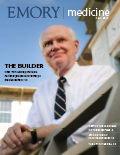Keeping the care team on the same page
|
|
When Jason Stein 98M was a medical student, he considered himself lucky if he was able to visit his patients with their assigned nurse present.
Very few times did their schedules ever sync so that they could do patient rounds together. Today, as a hospital medicine physician with Emory University Hospital (EUH), Stein has helped change the way care teams work together on medical-surgical units.
More than a year ago Stein was part of an Emory Healthcare committee charged with finding ways to improve patient care quality and communication between the health care team and patient. What the committee came up with has developed into structured interdisciplinary bedside rounds, or SIBR.
Every day, the unit's bedside physicians, residents, nurses, social worker, and pharmacist go from room to room to discuss each patient's progress with the patient and the patient's family. This way, everyone on the care team and the patient and family hear the same report and can update the care plan together.
"SIBR-ing" on each unit, with 12 to 15 patients, lasts about an hour each day. Physicians have been coached to sit at eye level with the patient and not to use jargon. "The physician talks with the patient, and the rest of the care team listens in," Stein says. "We're not talking about every medication and dosage. We address the patient and family's concerns and cross-check each other on the patient's progress. We're talking about the discharge plan every day." The care team also goes over a quality-safety checklist.
"Patients expect hospital professionals to coordinate with each other," Stein says. "Yet we have come to accept the practice of asynchronous care—hospital professionals filtering in and out of a patient's room at unpredictable times and without a shared model for how and what to communicate."
Many hospital teams' fractured communication is a product of an antiquated patient admittance system, Stein says. Doctors usually have patients on multiple floors and cannot predict where and when they will reach a specific room. For EUH's SIBR units, patients who are admitted become the responsibility of a physician assigned to the unit. Physicians assigned to a SIBR unit are dedicated almost entirely to patients on that unit.
Stein says he's a happier doctor—he practices on one unit and knows each care team member who works in the unit, something that was difficult when he was constantly traveling between units. He estimates that he receives 60% fewer pages every day simply because he is always on the unit and accessible.
Results also have been positive for patients. SIBR at EUH has been associated with a nearly 50% reduction in in-hospital mortality its first 12 months of implementation compared with the preceding 12 months. Patient length-of-stay has gone from an average of 5 to 4.5 days. Nursing turnover has gone from approximately one nurse per quarter to zero. Patients have commented that their care teams seem coordinated, and some incoming patients have even requested to stay on a SIBR unit, Stein says.
SIBR also has been implemented at Emory John's Creek Hospital. Stein recently traveled to Melbourne, Australia, to support the rollout of SIBR at several area hospitals, and closer to home, the Center for Medicare & Medicaid Innovation is evaluating the SIBR model and its outcomes.



